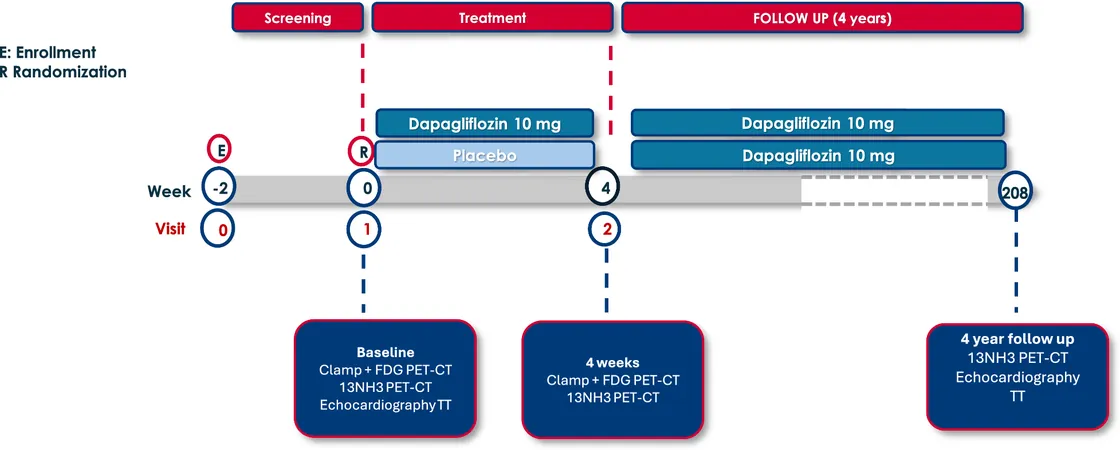
Revolutionary Heart Benefits of Dapagliflozin for Type 2 Diabetes Patients Revealed: DAPAHEART Study Insights
2025-08-31
Author: Sarah
Groundbreaking Study Unveils Long-Term Heart Benefits of Dapagliflozin
A recent follow-up study from the DAPAHEART trial has unveiled astonishing findings about the heart health benefits of dapagliflozin, particularly for patients battling type 2 diabetes mellitus (T2DM). After four years of treatment with this sodium-glucose cotransporter-2 inhibitor (SGLT2i), patients displayed a staggering 34.4% increase in coronary flow reserve (CFR) and a notable 29.18% reduction in epicardial adipose tissue (EAT) thickness.
What is Coronary Flow Reserve and Why Does It Matter?
CFR is a crucial indicator of heart health, measuring how well coronary arteries can boost blood flow during physical stress compared to rest. In diabetes patients, reduced CFR often signals severe microvascular dysfunction, which amplifies the risk of coronary complications. Enhancing CFR can significantly protect the heart from ischemic events.
How Dapagliflozin Works Its Magic
This pilot study previously showed that just four weeks of dapagliflozin treatment resulted in an impressive 30% improvement in CFR. Now, after a prolonged four-year follow-up, these benefits have been confirmed to persist. Notably, the reduction in EAT—an important fat depot linked to heart health—has also been maintained. This suggests that dapagliflozin not only offers immediate support but also long-lasting benefits that significantly lower cardiovascular risks.
DAPAHEART Trial Breakdown: Methodology and Results
The DAPAHEART study enrolled T2DM patients with stable coronary artery disease (CAD) in a randomized, double-blind format, where participants received either dapagliflozin (10 mg) or a placebo for an initial four weeks. Following this, all placebo participants transitioned to dapagliflozin. Researchers measured CFR and EAT thickness using state-of-the-art PET/CT imaging at baseline, four weeks, and four years.
Results were striking: CFR improved from 2.15 at baseline to 2.85 after four years, while EAT thickness decreased significantly from 0.62 cm to 0.44 cm. The body mass index (BMI) also saw a significant reduction, which further endorsed the positive health impacts of dapagliflozin.
Implications for Diabetes and Heart Disease Management
These findings underscore the need for incorporating dapagliflozin into the treatment regimens for T2DM patients, especially those at risk of CAD. The sustained improvements in heart function and structure reveal that SGLT2i treatments may play a pivotal role in revolutionizing cardiovascular care in the diabetic population.
Looking Ahead: The Need for Larger Studies
While the results are promising, the relatively small sample size of the study points to the need for larger trials to fully understand the long-term effects of dapagliflozin on heart health and its potential as a preventive measure against major cardiovascular events. Further research could solidify its place as a cornerstone in T2DM management.
Overall, the DAPAHEART follow-up study illuminates the transformative cardiovascular benefits of dapagliflozin, making it a significant beacon of hope for patients managing both diabetes and heart health.


 Brasil (PT)
Brasil (PT)
 Canada (EN)
Canada (EN)
 Chile (ES)
Chile (ES)
 Česko (CS)
Česko (CS)
 대한민국 (KO)
대한민국 (KO)
 España (ES)
España (ES)
 France (FR)
France (FR)
 Hong Kong (EN)
Hong Kong (EN)
 Italia (IT)
Italia (IT)
 日本 (JA)
日本 (JA)
 Magyarország (HU)
Magyarország (HU)
 Norge (NO)
Norge (NO)
 Polska (PL)
Polska (PL)
 Schweiz (DE)
Schweiz (DE)
 Singapore (EN)
Singapore (EN)
 Sverige (SV)
Sverige (SV)
 Suomi (FI)
Suomi (FI)
 Türkiye (TR)
Türkiye (TR)
 الإمارات العربية المتحدة (AR)
الإمارات العربية المتحدة (AR)